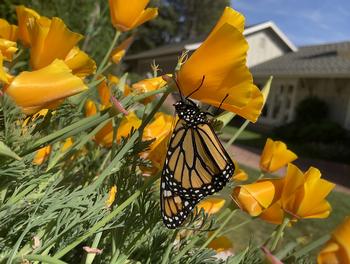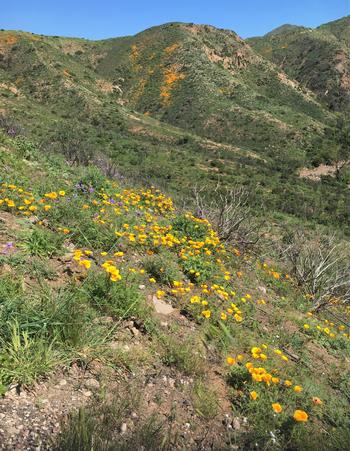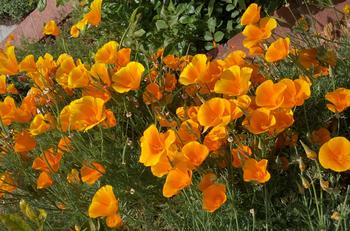The golden poppies of California
-
Alice Cason
-
The California Poppy, Eschscholzia californica, is a tough, fast-growing, drought-tolerant, self-seeding California native wildflower. It is indigenous to western North America. In 1816 a ship from the Russian Imperial Navy arrived in San Francisco Bay. Aboard was a Russian naturalist named Adelbert von Chamisso. He wrote about the California poppy he saw in the Presidio, giving it the name Eschscholzia californica after his friend Johann Eschscholtz, a physician on the ship. Early Spanish settlers called the plant “Copa del oro” or cup of gold after a legend that said the petals filled the soil with gold.
 CA poppies have no nectar, just pollen. Monarch butterflies like to sip the dew that accumulates in the cup attracted by the color. Alice Cason
CA poppies have no nectar, just pollen. Monarch butterflies like to sip the dew that accumulates in the cup attracted by the color. Alice CasonIn 1903 the California poppy became the official state flower of California. Perhaps it represented the “fields of gold” sought during the gold rush. It is commonly seen blooming in spring and summer along country roads and freeways, rocky slopes, maritime bluffs, and dunes, making it a highly recognizable symbol of the Golden State. April 6 each year is officially designated by the state as California Poppy Day.
It is often believed that laws prohibit cutting the California Poppy because it is the State flower. While no law protects the California Poppy specifically, the California Penal Code (384a) requires written permission from the landowner to remove and sell plant material from land the person does not own. This law does not prevent the landowners’ collection of poppies on private land. California Poppies are common along the rocky slopes, bluffs and roadsides of Marin County. Plantmaster
California Poppies are common along the rocky slopes, bluffs and roadsides of Marin County. PlantmasterCalifornia poppies are easy to grow and not fussy about the soil. In Marin County, they can be an annual, growing from seeds, or a perennial, growing from the previous year’s root base. They have a long tap root and do not transplant easily. Growing from seed or picking up young plants from a nursery is better than transplanting. Propagation techniques include direct sowing into prepared soil—plant where it has room to roam and to reappear every spring. Full sun is best, and some shade is tolerated. In Marin, it is common in meadows, grassy flats, rocky slopes, dunes and bluffs, and along the roadsides.
California poppies are deer resistant. They provide pollen (not nectar) to birds, butterflies, bees, and other pollinators. Monarch butterflies can be seen being able to rest and sip the dew that accumulates in the cup, which is just the right size on which to land, and the right color to attract. It is often early and late blooming.
To save seed from the poppy plant, wait until the seed pods form. Collect them inside a paper bag. Store the bag in a warm place (like a garage), and as the seeds dry, the pods will pop open and collect in the bag. Save the seed until it is time to sow after the first fall rain, or if rain is absent, water until the seeds germinate, then water the plant every three weeks, ensuring the root ball remains moist. You will be amazed at the results.
Native Americans used the golden poppy for food and medicine. All parts of the plant (leaves, stems, seeds, and roots) have been used for sedative and mild psychoactive effects. Different alkaloids are contained in various parts of the plant and are used to induce a mild state of euphoria. Early Spanish settlers called the golden poppy “Dormidera,” the drowsy one, because at night and on overcast days, the flower stays closed with petals tightly wrapped. On a sunny day, you will see them open; on a cloudy day, they stay closed. CA poppies can be found from So. Washington to Baja California. Flowers can be seen in Nevada & Arizona & the foothills of So. California. Alice Cason
CA poppies can be found from So. Washington to Baja California. Flowers can be seen in Nevada & Arizona & the foothills of So. California. Alice CasonRemember that native plants are the key to a sustainable, earth-friendly garden. They conserve water, reduce maintenance, and provide a habitat for beneficial insects. No pesticides, herbicides, or fertilizers are needed. Growing native wildflowers helps us to create wildlife corridors connected with urban landscapes creating continuous habitat throughout Marin County.
For more about growing California native plants, use the UCMarin Master Gardeners website: https://marinmg.ucanr.edu/PLANTS/CAL_NATIVE_PLANTS/ and see the list of easy California native plants.



